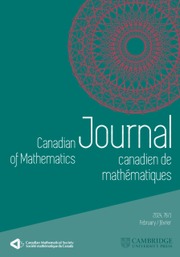No CrossRef data available.
Article contents
Minimum non-chromatic-choosable graphs with given chromatic number
Published online by Cambridge University Press: 27 December 2024
Abstract
A graph G is called chromatic-choosable if  $\chi (G)=ch(G)$. A natural problem is to determine the minimum number of vertices in a non-chromatic-choosable graph with given chromatic number. It was conjectured by Ohba, and proved by Noel, Reed, and Wu that k-chromatic graphs G with
$\chi (G)=ch(G)$. A natural problem is to determine the minimum number of vertices in a non-chromatic-choosable graph with given chromatic number. It was conjectured by Ohba, and proved by Noel, Reed, and Wu that k-chromatic graphs G with  $|V(G)| \le 2k+1$ are chromatic-choosable. This upper bound on
$|V(G)| \le 2k+1$ are chromatic-choosable. This upper bound on  $|V(G)|$ is tight. It is known that if k is even, then
$|V(G)|$ is tight. It is known that if k is even, then  $G=K_{3 \star (k/2+1), 1 \star (k/2-1)}$ and
$G=K_{3 \star (k/2+1), 1 \star (k/2-1)}$ and  $G=K_{4, 2 \star (k-1)}$ are non-chromatic-choosable k-chromatic graphs with
$G=K_{4, 2 \star (k-1)}$ are non-chromatic-choosable k-chromatic graphs with  $|V(G)| =2 k+2$. Some subgraphs of these two graphs are also non-chromatic-choosable. The main result of this paper is that all other k-chromatic graphs G with
$|V(G)| =2 k+2$. Some subgraphs of these two graphs are also non-chromatic-choosable. The main result of this paper is that all other k-chromatic graphs G with  $|V(G)| =2 k+2$ are chromatic-choosable. In particular, if
$|V(G)| =2 k+2$ are chromatic-choosable. In particular, if  $\chi (G)$ is odd and
$\chi (G)$ is odd and  $|V(G)| \le 2\chi (G)+2$, then G is chromatic-choosable, which was conjectured by Noel.
$|V(G)| \le 2\chi (G)+2$, then G is chromatic-choosable, which was conjectured by Noel.
Keywords
MSC classification
Information
- Type
- Article
- Information
- Copyright
- © The Author(s), 2024. Published by Cambridge University Press on behalf of Canadian Mathematical Society
Footnotes
This work was supported by the NSFC (Grant Nos. 12371359 and U20A2068).


